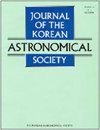KMTNET: A NETWORK OF 1.6 M WIDE-FIELD OPTICAL TELESCOPES INSTALLED AT THREE SOUTHERN OBSERVATORIES
IF 0.8
4区 物理与天体物理
Q3 ASTRONOMY & ASTROPHYSICS
引用次数: 146
Abstract
The Korea Microlensing Telescope Network (KMTNet) is a wide-field photometric system installed by the Korea Astronomy and Space Science Institute (KASI). Here, we present the overall technical specifications of the KMTNet observation system, test observation results, data transfer and image processing procedure, and finally, the KMTNet science programs. The system consists of three 1.6 m wide-field optical telescopes equipped with mosaic CCD cameras of 18k by 18k pixels. Each telescope provides a 2.0 by 2.0 square degree field of view. We have finished installing all three telescopes and cameras sequentially at the Cerro-Tololo Inter-American Observatory (CTIO) in Chile, the South African Astronomical Observatory (SAAO) in South Africa, and the Siding Spring Observatory (SSO) in Australia. This network of telescopes, which is spread over three different continents at a similar latitude of about -30 degrees, enables 24-hour continuous monitoring of targets observable in the Southern Hemisphere. The test observations showed good image quality that meets the seeing requirement of less than 1.0 arcsec in I-band. All of the observation data are transferred to the KMTNet data center at KASI via the international network communication and are processed with the KMTNet data pipeline. The primary scientific goal of the KMTNet is to discover numerous extrasolar planets toward the Galactic bulge by using the gravitational microlensing technique, especially earth-mass planets in the habitable zone. During the non-bulge season, the system is used for wide-field photometric survey science on supernovae, asteroids, and external galaxies.Kmtnet:安装在三个南方天文台的1.6米宽视场光学望远镜网络
韩国微透镜望远镜网络(KMTNet)是由韩国天文空间科学研究院(KASI)安装的宽视场光度测量系统。本文介绍了KMTNet观测系统的总体技术指标、试验观测结果、数据传输和图像处理过程,最后介绍了KMTNet科学方案。该系统由三个1.6 m宽视场光学望远镜组成,配有18k × 18k像素的马赛克CCD相机。每个望远镜提供一个2.0乘2.0平方度的视野。我们已经先后在智利的Cerro-Tololo美洲天文台(CTIO)、南非天文台(SAAO)和澳大利亚的Siding Spring天文台(SSO)安装了三架望远镜和相机。这个望远镜网络分布在三个不同的大陆上,纬度相似,约为-30度,可以24小时连续监测南半球可观测的目标。测试观测结果表明,图像质量良好,满足i波段小于1.0弧秒的可视要求。所有观测数据通过国际网络通信传输到KASI的KMTNet数据中心,并使用KMTNet数据管道进行处理。KMTNet的主要科学目标是利用引力微透镜技术在银河系隆起处发现大量系外行星,特别是在宜居带中发现地球质量的行星。在非膨胀季节,该系统用于超新星、小行星和外部星系的宽视场光度测量科学。
本文章由计算机程序翻译,如有差异,请以英文原文为准。
求助全文
约1分钟内获得全文
求助全文
来源期刊

Journal of the Korean Astronomical Society
地学天文-天文与天体物理
CiteScore
1.30
自引率
10.00%
发文量
0
审稿时长
>12 weeks
期刊介绍:
JKAS is an international scientific journal publishing papers in all fields of astronomy and astrophysics. All manuscripts are subject to the scrutiny of referees. Manuscripts submitted to JKAS must comply with the ethics policy of JKAS. Six regular issues are published each year on February 28, April 30, June 30, August 31, October 31, and December 31. One year''s issues compose one volume.
 求助内容:
求助内容: 应助结果提醒方式:
应助结果提醒方式:


